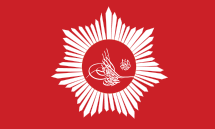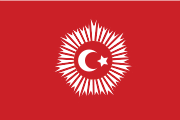- Ottoman flag
-
 The Şeyhülislam declaring Jihad against the Entente in 1914,[1] with Ottoman flags placed in front of the podium.
The Şeyhülislam declaring Jihad against the Entente in 1914,[1] with Ottoman flags placed in front of the podium.
The term Ottoman flag refers to any of the flags used by the ruling Sultans of the Ottoman Dynasty. Various flags were used within the Ottoman Empire during its existence, and the sultan also used different personal flags on different occasions of state. Due to the complex social and political organisation of the Ottoman Empire, throughout most of its history there was no single proper national flag, until 1844. In 1844, as part of the Tanzimat reforms, the first official national flag of the Ottoman Empire was adopted. This flag, which had a five-pointed star and crescent, also formed the basis of the present-day flag of the Republic of Turkey. The crescent moon in the Ottoman Flag was often thicker than its present form (see photo).
Contents
Flags from ghazi to emperor (1299-1453)
- 1299-1453
The early years were a time of the Ottomans defining themselves, a process which did not come to a conclusion until they took Constantinople in 1453. Osman I, a ghazi warlord in Söğüt and the founder of the Ottoman Empire, was acclaimed the Khan of the Kayıhan in 1299 and it was this title that he bore to his death, establishing the backbone upon which the empire was founded. He inherited this title from his father Ertugrul, who inherited it from his father Suleyman Shah, who inherited it from his father Kayaalp, this going back to when the Kayihan were a roving tribe of Oghuz nomads who inhabited the area surrounding Mount Khan Tengri.
Osman's grandson Murad I, who bore the level of Roman legitimacy his father could only dream of, ironically reversed his father's policy and forged a completely new identity for the domains, casting off any claim to Roman legitimacy or tribal affiliations and founding the Ottoman Empire. Why red was the perfect colour to say this with, we shall never know. It has no bearing to traditional tribal colours (which were white and gold) or popular Turkic colours (usually blue, white and gold). It could be because it was a colour associated with the Romans, and he was not casting off Roman aspirations as totally as we would be led to believe. Red might just have been his favourite colour, like Napoleon and the green stripe on the Italian flag.
Flags of the Sublime Porte (1453-1793)
- 1453-1793
-
Flag of an Albanian Merchant 1453-1793
The original flag changed very little, the gold crescent merely makes its appearance for the first time. By the 18th century this began to be flown as a rectangular as opposed to triangular flag, but remained essentially unchanged. The gold is actual gold-woven silk, and in lieu of this white cloth as opposed to yellow-dyed cloth was used, as not everyone could afford such luxury.
The crescent was an ancient symbol of Byzantium and Constantinople. In some Turkish clans and kingdoms, the crescent-shaped symbols were used extensively. The crescent was quite popular in Persia, which was the origin of most of the non-Roman Ottoman culture at that point, and it was remarkably similar to the Kayi clan tamgha from which Osman was descended and the Khanate of which the Ottoman state emerged. The crescent for the Ottoman Empire therefore was a powerful message as well as an appropriate symbol, binding the past to the future.
With control of Constantinople and the Bosphorus came new commercial opportunities and new threats from Venice and Genoa, who feared for their interests and colonies in the Aegean and Black Sea. The Ottomans felt the need for a strong navy and merchant marine, and instituted a number of reforms. These included naval identification flags, including flags signifying command ships, and a set of merchant flags based on religion, each of which was treated differently by the legal system. The naval system also had flags for individual ships and commanders, but those could not be considered to be "Ottoman" flags.
With the conquest of Syria and Egypt, a new Imperial flag was needed. The Sultan was no longer a Roman successor in a mostly Christian land, but the Sultan of Egypt and Caliph of Islam. So the Byzantine cross was removed, and a disc of the colour green, the colour of Islam, was placed upon the imperial flag. The many-crescents motif was maintained, but was reduced to three upon the disc, and now represented the three titles and three continents that the house of Osman ruled over: Egypt in Africa, the Caliphate in Asia, and Rûm in Europe.
Reform and decline (1793-1923)
- 1453-1793
After the Tanzimat (1844-1923)
- 1844-1923
-
The late Ottoman Navy flag with an eight-pointed star and crescent was used between 1793 and 1844
-
Flag of the Ottoman Caliphate used between 1844 and 1923[citation needed]
-
The last flag of the Ottoman Empire from 1844 to 1923 was adopted with the Tanzimat reforms as the first official Ottoman national flag
-
Declaration of the Young Turk Revolution in 1908 by the leaders of the Ottoman millets, with a pair of Ottoman flags in the background.
The flag of the Ottoman navy was made red as red was to be the flag of secular institutions and green of religious ones, following the New Order reforms. All religious institutions were "spun off" and while the emperor remained caliph and retained religious roles, the sultanate secularized itself. The navy went through radical modernization reforms, but nothing compared to the army.
The army was completely restructured. The janissaries were disbanded and many of them were killed as they resisted modernization. This came of course with a new flag design, without the colour, religious overtones, and excess of the janissaries, and in the style of European armies of the day it was a bicolour flag containing the two, now official, Ottoman colours.
Furthering the New Order reforms, the Empire was centralised and all the various sub-sultanates, pashaliks, beyliks and emirates were abolished, including the Ottoman Sultanate. A new flag was designed to replace all these flags with one single national flag. The result was the red and white flag with the crescent moon and star, which is the precursor to the modern Turkish flag. Secularisation made the religions equal under law, doing away with the complex hierarchy of religions in relation to taxation and mercantile pursuits, so a plain red flag was made the civil flag for all Ottoman subjects.
Relation to the flag of the Republic of Turkey
Main article: Flag of TurkeyAfter the fall of the Ottoman Empire in the wake of World War I and the foundation of the Republic of Turkey following the Turkish War of Independence, the new Turkish state maintained the last flag of 1844 of the Turkish Empire, but introduced proportional standardisations. The flag of Turkey bears, on a red background, the white crescent moon and a five-pointed star with definite geometrical proportions, established and regulated by the Turkish Flag Law (Turkish: Türk Bayrağı Kanunu) since 1936.
Personal standard of the sultan


Standard of the Ottoman Sultan.[2]
(Late 19th-1923)
* Standard of the Sultan.
(Each Sultan had his own Tughra)
* Version used at sea.The imperial banners displayed the sultan's tughra, often on a pink or bright red background. The religious colour of Islam is green, and many Ottoman flags were dark green (either simple green flags, or bearing the star and crescent in either white or yellow). Many royal banners picture the legendary Zulfikar sword. As of 1862 the flag of the sultan was green with seven thin, red, horizontal lines.
Flag poles
The flagpoles were often decorated by a crescent, a wolf's head, a horsetail or a Qur'an box. In addition, banners were always accompanied by a number of smaller flags, pennants, icons and various other items with symbolic meaning (for example, the Janissaries used to parade with their cauldrons).
References
- Catalan Atlas, Cresques Abraham 1375
- Topkapı Museum, Flag Exhibit, Istanbul
- Ottoman Painted Miniatures, Turkish Ministry of Culture
- Portolan Chart, Petrus Roselli, 1466
- Portolan Chart, Albino de Canepa, 1489
- Flags of the World, Ottoman Empire
External links
Categories:- Flags of Egypt
- Historical flags
- History of the Ottoman Empire
- National symbols of Turkey
- Politics of the Ottoman Empire
- Obsolete national flags
Wikimedia Foundation. 2010.





















